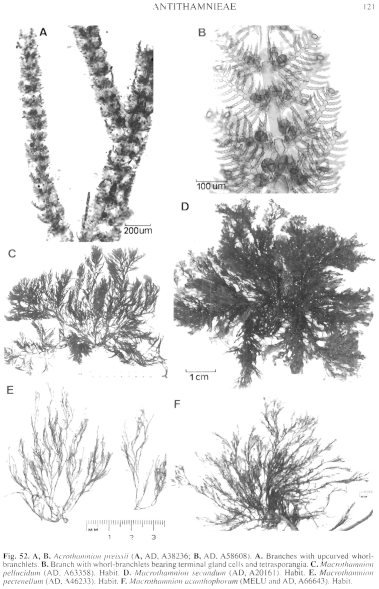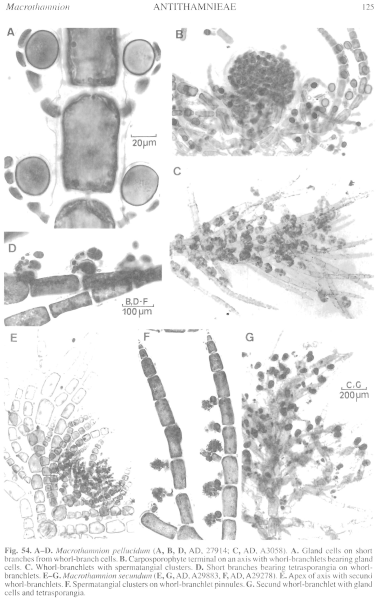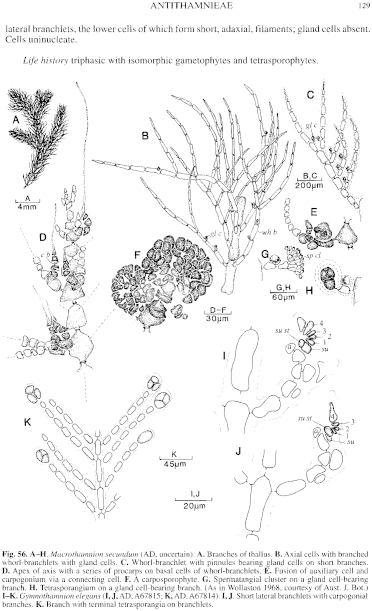|
|
|
|
|
|||||||||||
|
Electronic Flora of South Australia Species Fact Sheet
Phylum Rhodophyta – Order Ceramiales – Family Ceramiaceae – Tribe Antithamnieae
Thallus (Figs 52D, 56A) medium to dark red-brown, erect, 1–4 (–12) cm high, much branched with several bushy axes, each axial cell with 3 whorl-branchlets, axes loosely corticated with rhizoids below. Holdfast rhizoidal, 2–10 mm across; epilithic or epiphytic. Structure. Apical cells 7–12 w in diameter and L/D 1–1.5, enlarging to axial cells 130–400 µm in diameter and L/D (1–) 2–4. Whorl-branchlets (Figs 54E, 56B) 0.8–1.5 mm long, usually secundly branched with 1–5 simple pinnules, basal cells 40–100 µm in diameter and L/D 1–1.2, cells above L/D 2–3, tapering to subterminal cells 15–30 µm in diameter and L/D 1.5–2, terminal cells mucronate. Corticating rhizoids 25–35 (–50) µm in diameter, cells L/D 4–6; gland cells (Fig. 56C) borne on special 2–3-celled short branches, single (or with 2–3), ovoid, 16–25 (–35) µm in diameter. Lateral branches arise irregularly 4–8 axial cells apart, on the basal cells of whorl-branchlets. Cells uninucleate; rhodoplasts discoid to elongate in smaller cells, ribbon like in larger cells.
Reproduction: Gametophytes dioecious. Carpogonial branches (Fig. 56D) borne on the basal (= supporting) cell of numerous (up to 18) whorl-branchlets near apices, with the auxiliary cell cutting off a gonimoblast cell which produces several gonimolobes; fusion occurs between the axial cell, residual supporting cell and the foot cell (Fig. 56E), and the carposporophyte (Fig. 56F) is largely covered by upcurved whorl-branchlets from below. Spermatangia occur on special short branches (Figs 54F, 56G) on the basal cell of gland-cell branches.
Tetrasporangia occur successively on the special branches (Figs 54G, 56H) bearing the gland cells, 1–3 per cell, sessile, ovoid, 50–90 µm in diameter, decussately divided.
Type from Vivonne Bay, Kangaroo I., S. Aust., lower eulittoral pools (Wollaston, 30.i.1956); holotype and isotypes in AD, A20161.
Selected specimens: Pearson Is, S. Aust., 36 m deep (Shepherd, 10.i.1969; AD, A34159). N Spencer Gulf, S. Aust., on Posidonia, 6 m deep (Shepherd, 5.ix.1973; AD, A44177), on Sargassum, 10 m deep (Shepherd, 5.ix.1973; AD, A44224) and on Amphibolis, 15 m deep (Shepherd, 7.ix.1973; AD, A44297). Investigator Strait, S. Aust., 31 m deep (Watson, 24.i.1971; AD, A41000). Tunkalilla Beach, S. Aust., upper sublittoral on reef (Wollaston, 20.xii.1964; AD, A28524). Pennington Bay, Kangaroo I., S. Aust., eulittoral pools (Womersley, 19.i.1948; AD, A6500). 2 km E of Penneshaw, Kangaroo I., S. Aust., 19–22 m deep (Hone, 10.ii.1997; AD, A66984). Robe, S. Aust., drift (Wollaston, 17.v.1965; AD, A29278). Nora Creina, S. Aust., upper sublittoral pools (Wollaston, 14.xi.1955; AD, A20031). Port Phillip Heads, Vic. (Wilson, 27.i.1892; NSW, as Wrangelia incurva, and AD, A33178).
Distribution: Pearson Is to Port Phillip Heads, Victoria.
Taxonomic notes: M. secundum is often a shallow water species on rough-water coasts, but occurs at depth in northern Spencer Gulf and Backstairs Passage, E of Penneshaw.
References:
WOLLASTON, E.M. (1968).Morphology and taxonomy of southern Australian genera of Crouanieae Schmitz (Ceramiaceae, Rhodophyta). Aust. J. Bot. 16, 217–417.
The Marine Benthic Flora of Southern Australia Part IIIC complete list of references.
Publication:
Womersley, H.B.S. (24 December, 1998)
The Marine Benthic Flora of Southern Australia
Rhodophyta. Part IIIC. Ceramiales – Ceramiaceae, Dasyaceae
©State Herbarium of South Australia, Government of South Australia
Illustrations in Womersley Part IIIA, 1998: FIGS 52D, 54 E–G, 56.

Figure 52 enlarge
Fig. 52. A, B. Acrothamnion preissii (A, AD, A38236; B, AD, A58608). A. Branches with upcurved whorl-branchlets. B. Branch with whorl-branchlets bearing terminal gland cells and tetrasporangia. C. Macrothamnion pellucidum (AD, A63358). Habit. D. Macrothamnion secundum (AD, A20161). Habit. E. Macrothamnion pectenellum (AD, A46233). Habit. F. Macrothamnion acanthophorum (MELU and AD, A66643). Habit.

Figure 54 enlarge
Fig. 54. A–D. Macrothamnion pellucidum (A, B, D, AD, 27914; C, AD, A3058). A. Gland cells on short branches from whorl-branch cells. B. Carposporophyte terminal on an axis with whorl-branchlets bearing gland cells. C. Whorl-branchlets with spermatangial clusters. D. Short branches bearing tetrasporangia on whorl-branchlets. E–G. Macrothamnion secundum (E, G, AD, A29883, F, AD, A29278). E. Apex of axis with secund whorl-branchlets. F. Spermatangial clusters on whorl-branchlet pinnules. G. Secund whorl-branchlet with gland cells and tetrasporangia.

Figure 56 enlarge
Fig. 56. A–H. Macrothamnion secundum (AD, uncertain). A. Branches of thallus. B. Axial cells with branched whorl-branchlets with gland cells. C. Whorl-branchlet with pinnules bearing gland cells on short branches. D. Apex of axis with a series of procarps on basal cells of whorl-branchlets. E. Fusion of auxiliary cell and carpogonium via a connecting cell. F. A carposporophyte. G. Spermatangial cluster on a gland cell-bearing branch. H. Tetrasporangium on a gland cell-bearing branch. (As in Wollaston 1968, courtesy of Aust. J. Bot.) I–K. Gymnothamnion elegans (I, J, AD, A67815; K, AD, A67814). I, J. Short lateral branchlets with carpogonial branches. K. Branch with terminal tetrasporangia on branchlets.

|
Email Contact: State Herbarium of South Australia |

|